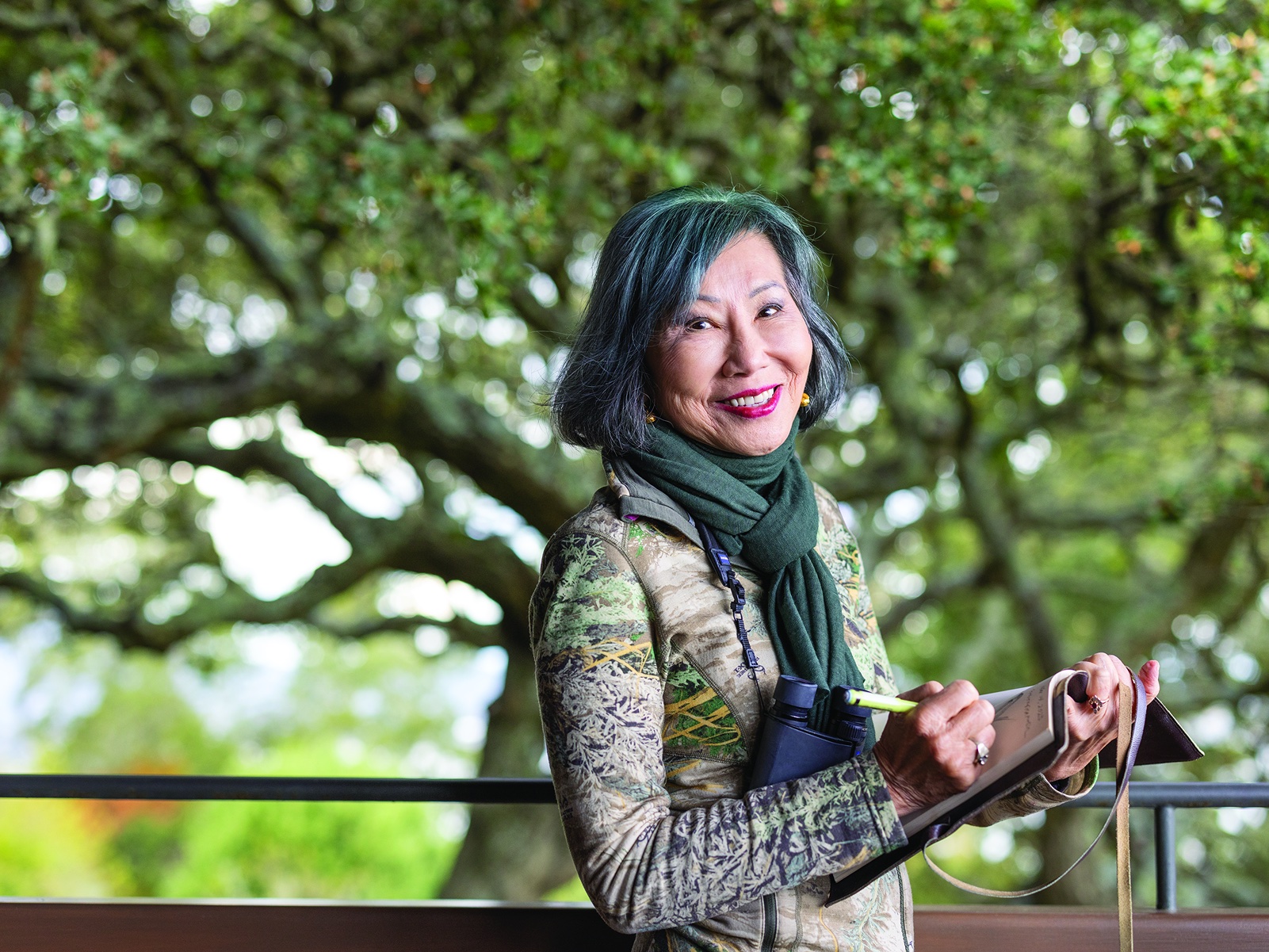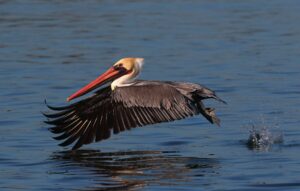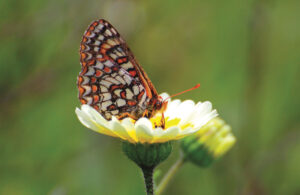Bestselling author of titles including The Joy Luck Club and The Bonesetter’s Daughter, Amy Tan lives and works in a Bay Area home surrounded by oak trees and their brushy understory. It is a bird haven, and some years ago Tan took an interest in them, loading her leafy yard with feeders, offering suet, live mealworms, and seeds each day to attract feathered company. She has watched their lives unfold, and it is the stuff of novels. Tan has filled journals with anecdotes, observations, and drawings of her birds, and in spring 2024, Penguin is publishing a selection of her journal entries in a new book, The Backyard Bird Chronicles. Bay Nature’s editor, Victoria Schlesinger, caught up with Tan to ask about the book. The conversation has been edited for clarity and length.
VS: Let’s set the scene. Tell me where your backyard is and some of the species that visit it.
AT: My yard is in Sausalito, California, in Marin County. I’m very, very lucky in that I have a woodland setting with oak trees. I have a lot of understory brush where birds can hide, and a lot of feeders—I’m surrounded by trees on three sides of the area where I work. It’s always possible to see something going on.
I have, on a year-round basis, chestnut-backed chickadees, pygmy nuthatches, oak titmice, Bewick’s wrens, scrub-jays, dark-eyed juncos, California towhees, spotted towhees, finches. And I’ve had owls, too. And then, during migration, the golden-crown sparrows come back, as do Townsend’s warblers. I’m expecting the hermit thrush soon, but we already have the fox sparrows. We’ll end up getting about 20 species. At most I might count 25 in a day.
VS: Your new book is a collection of diary-style vignettes about your backyard birds—but it’s also your nature journal. Can you talk about how you got into nature journaling, and how it has helped you learn about birds?
AT: It’s a little strange that it wasn’t until recently that I paid much attention to birds. I was aware of crows and hummingbirds—although I didn’t know their names—and of scrub-jays, which I used to call blue jays, like a lot of people.
But in 2016, after the election, there was a lot of overt racism. I even had it directed to me—or I would feel that it was directed to me: whenever I got rude service or somebody gave me a nasty look, I thought, “It’s out in the open now.”
And I was so distressed by this, I needed to find something that would calm me down and give me a little bit of peace at times. I decided to turn to nature, which I’ve always loved. I remembered that there was a guy named Jack Laws [John Muir Laws] who taught nature drawing. I took some classes and I ended up practicing every day and filled up cheap journals with my practice drawings.
After a while I became even more fascinated with bird behavior, so I changed the focus of my drawing to try to ask questions about what I was seeing—being aware that I cannot assign intentionality to what birds are doing, but allowing myself playful anthropomorphism, and using that as a platform for discussing aspects of bird behavior.
VS: Some people think of birding as a hobby where you see a bird and check it off a list. But in this book, you’re devoted to observing bird behavior over time.
AT: Yes, but I do acknowledge that what I have in the backyard is a very artificial situation for birds. All these species don’t normally feed together. Some are up in the trees, some are pecking under bark or flying after insects. So I’m aware of that, but it’s still interesting to me.
Part of feeding the birds every day, and them seeing me every day, is that they become accustomed to me. Every bird is special, but the most special one is the one that looks up and sees me and then goes back to what it was doing—usually eating. Which means to me that I’m a normal part of that bird’s world. I’m accepted. I love the fact that birds are wild, and it is thrilling that a wild animal accepts me into its world. So I’m very protective of these birds, and as a consequence, I started getting more into conservation: I’m now on the board of American Bird Conservancy, despite vowing to myself that I would never join a board!
VS: So much information about birding and bird behavior is packed into the book, and yet I never felt like I was reading a textbook or guidebook. As you were journaling, were you conscious of wanting to teach others?
AT: I think of myself as a very curious person. It’s just the way that I think, and the way that I follow my interests. I was educating myself, but not anyone else. What you don’t see in the finished book are nine other volumes of my journals; I only took extracts of what I was learning along the way. I did read many, many books. From Bernd Heinrich’s books, I learned the great discoveries that come about when you are patient and you watch the same thing over and over again, every day, every season, and every year. I had that mindset when I was thinking about what I wanted to do with my observations.
There’s a particular question that I asked myself that many people ask: “Why do birds throw seeds on the ground that are perfectly edible?” I wondered if anybody had ever written about this, and sure enough, my good old friend Bernd Heinrich had researched this in the late ‘90s. In one study, Heinrich found that nuthatches and chickadees preferred seeds that were heavier over those that were lighter.
VS: You share a lot of your own casual experiments in the book, showing people how to create their own tools for learning.
AT: One of the intriguing experiments was about how opportunistic and adaptable birds are to their environment. For example, there are ground feeders and there are perchers. The sparrows are ground feeders. They eat off the ground. They dig up things. They eat insects, whatever. And the perchers are the ones that sit at your feeder and eat the seeds.
Early on, when I started looking at birds, I asked on some Facebook page, “What seeds do juncos like to eat? What should I get for the feeder?” And somebody very sternly—or at least I perceived it to be sternly—said, “You should get a book and learn first what these birds are, for some basic information. This sparrow is a ground feeder and would never go to a feeder.”
So I felt virtually slapped and then I started thinking, well, what’s to prevent these birds from eating out of the feeder? What is it about their structure, their behavior, that kind of skulking about that they do in the bushes that makes it more likely they would always stay on the ground and never go up to the feeder?
If I have food on the ground, well, they’re certainly going to eat it. What if I put the food on a platform and then just kept moving that platform higher? What if I eventually put it in a bird-feeding cage? How adaptable would these birds be in order to get food? And I learned that in fact they are very adaptable. And I would say almost every single ground feeder learned to get into the cage.
VS: Why do you think you have gotten so into birding? What is it that’s pulled you in so deep?
AT: Well, birds are so incredibly beautiful, and give you so much to wonder about. They’re wild, and yet you can get them to look at you. Sometimes we just look at each other for the longest time.
And we have a relationship now. We both exist in the same world. We acknowledge each other. We know we’re not going to kill each other. I’m happy to share my food, and I’m not going to take away their food. I think it’s as simple as that. When I’m in the yard first thing in the morning, I pretty quickly hear squeaks and chirps and then more and more and more. And I know it’s the morning call, “breakfast is served!” So I think the birds are excited to see me because I represent fresh food.
I know that to be true also because on certain occasions I’ve had to take the feeders down. There were outbreaks of disease, and when I saw it in one bird early on, it just broke my heart. I would take the feeders down, sometimes for months. But the birds would still come for a while and they would look at me through the window. I’d be brushing my teeth, and there’d be a bird staring at me. A lot of people say, “Oh, they’re just fighting their reflection.” But no, the bird is looking at me. And then it taps its beak on a window, like “yoohoo, I’m here!”
VS: In this book, I could recognize your voice from your past novels. There’s a lot of spunk and humor, which you don’t get all the time in bird books. Anybody who’s read your fiction will feel you in this book.
AT: Thank you. I do think that the birds afford stories that are tragic and comedic, very dramatic love stories, stories of betrayal—they’re all there. And they’re funny! A lot of things birds do just leave me laughing, especially when they’re fledglings and try to jump onto something, and they miss and just scream for their parents to come. I just find that hilarious.
VS: Are there things you hope readers take away from the book?
AT: If they don’t already love birds, I hope they fall in love with birds. Because once you love a bird, you want to protect birds. I hope that readers can be aware that birds commonly die because of window collisions, and billions of birds a year in the U.S. alone are the victims of cats. I hope that people love birds because it gives them a sense of calm and peace. That they want to be more in nature, and then not just protect birds, but protect nature.
I do say to people who don’t have a yard, or have neighbors or a homeowner’s association that doesn’t allow bird feeders, that one of the easiest ways to attract birds is to set up water bowls. Put out a lot of water bowls, change the water every day, and put a rock in it so the birds know how deep it is. Eventually, birds will come every day.
There are a lot of people against feeding birds, saying they can find plenty of food and natural resources. Well, our yard is filled with flowers that hummingbirds love, and we have plants with seeds. But when it rains really hard and the insects are drowned or go into hiding, and those wonderful blooms are soggy and wilted, and it’s really cold out, it’s hard for a little bird to find something to eat if they’re inexperienced. And I see how inexperienced they are when they try to pick up, say, an acorn—when a little, tiny bird picks up an acorn and tries to eat it. So I do think they need a little help at certain times.
VS: This interview will be in Bay Nature’s winter issue. Do you have thoughts about what new backyard birders should be doing or watching for during that season?
AT: Winter migration into spring is a great transition period because you will be, possibly, hearing owls duetting in courtship. And you might see other courtship in larger raptors. They’re among the first to nest and have fledglings, although it takes longer for their babies to actually fledge.
The migrants start to leave for their homes up north, and you see them changing their plumage. You have the golden-crowned sparrows bathing every single day, multiple times a day as they molt and change into their wedding outfits—I call them that, their breeding plumage. It’s so startling when all of them change into that color. And then you start to see a lot of birds going back and forth to feed their babies, and certain birds feeding their mates and gathering food. You learn the signs, because they’re going back and forth, back and forth, back and forth, sometimes every 30 seconds. And that’s because babies eat an incredible amount of food every day.
And sometimes your yard empties, because the birds have found there’s a yard that has better blooms. And they will desert you. They have no loyalty. So you’ll go through a lot of emotion—anticipation, excitement, gratitude, and then disappointment and feelings of being betrayed. It’s just a very emotional way to see the world. And it becomes a way for people to live more deeply, more in the moment, in a meditative way that allows them to reflect on their own lives, and what’s important.
For more information about The Backyard Bird Chronicles, visit www.amytan.net.





